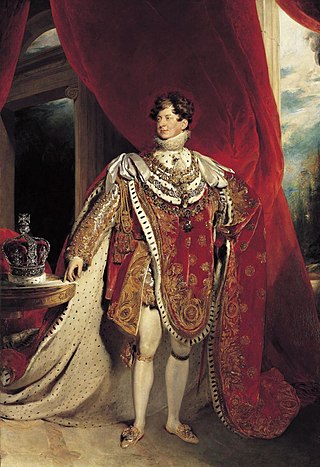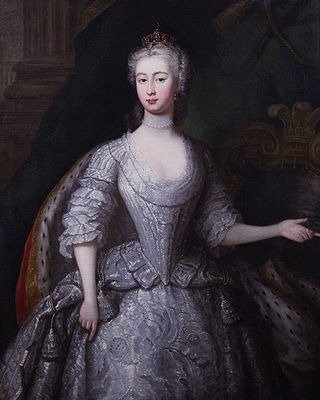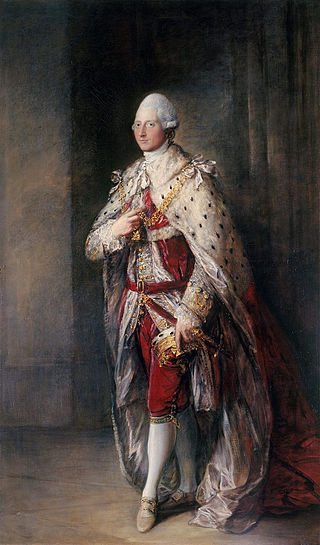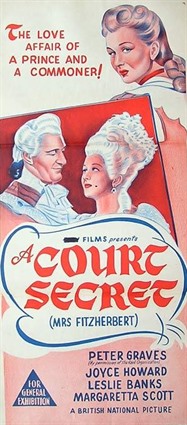
George IV was King of the United Kingdom of Great Britain and Ireland and King of Hanover from 29 January 1820 until his death in 1830. At the time of his accession to the throne, he was acting as prince regent for his father, George III, having done so since 5 February 1811 during his father's final mental illness.

Caroline of Brunswick-Wolfenbüttel was Queen of the United Kingdom of Great Britain and Ireland and Queen of Hanover from 29 January 1820 until her death in 1821 as the estranged wife of King George IV. She was Princess of Wales from 1795 to 1820.

Princess Augusta of Saxe-Gotha-Altenburg was Princess of Wales by marriage to Frederick, Prince of Wales, eldest son and heir apparent of King George II. She never became queen consort, as Frederick predeceased his father in 1751. Augusta's eldest son succeeded her father-in-law as George III in 1760. After her spouse died, Augusta was the presumptive regent of Great Britain in the event of a regency, until her son reached majority in 1756.

Maria Anne Fitzherbert was a longtime companion of George, Prince of Wales. In 1785, they secretly contracted a marriage that was invalid under English civil law because his father, King George III, had not consented to it. Fitzherbert was a Catholic and the law at the time forbade Catholics or spouses of Catholics from becoming monarch, so had the marriage been approved and valid, the Prince of Wales would have lost his place in the line of succession. Before marrying George, Fitzherbert had been twice widowed. Her nephew from her first marriage, Cardinal Weld, persuaded Pope Pius VII to declare the marriage sacramentally valid.

Princess Charlotte Augusta of Wales was the only child of George, Prince of Wales, and his wife, Caroline of Brunswick. She was expected to ascend the British throne after the deaths of her grandfather, George III, and her father, but died in childbirth at the age of 21, predeceasing them both.

William Cavendish, 5th Duke of Devonshire,, was a British nobleman, aristocrat, and politician. He was the eldest son of William Cavendish, 4th Duke of Devonshire, by his wife, the heiress Lady Charlotte Boyle, suo jure Baroness Clifford, who brought in considerable money and estates to the Cavendish family. He was invited to join the Cabinet on three occasions, but declined each offer. He was Lord High Treasurer of Ireland and Governor of Cork, and Lord Lieutenant of Derbyshire. In 1782, he was made a Knight of the Order of the Garter.

Prince Henry, Duke of Cumberland and Strathearn was the sixth child and fourth son of Frederick, Prince of Wales, and Princess Augusta of Saxe-Gotha, and a younger brother of George III. His 1771 marriage to a commoner against the King's wishes prompted the Royal Marriages Act 1772.

The use of the title of Princess of the United Kingdom of Great Britain and Northern Ireland is entirely at the will of the sovereign as expressed in letters patent. Individuals holding the title of princess are styled "Her Royal Highness" (HRH). On 18 April 1917, Frederica of Hanover, the newest granddaughter of Wilhelm II, German Emperor was styled a British princess from birth, even though Germany and Britain were fighting in World War I. Before the First World War, British princesses also held additional German titles, such as princesses of Hanover by virtue of being male-line descendants of George III; or princesses of Saxe-Coburg and Gotha, duchess of Saxony, by virtue of being male-line descendants of Prince Albert of Saxe-Coburg and Gotha. George V issued letters patent on 30 November 1917, to restrict the automatic assignment of the title "princess" and the use of the style "Royal Highness" to the following persons:

Princess Elizabeth, called Eliza, was the seventh child and third daughter of King George III and Queen Charlotte. After marrying the Landgrave of Hesse-Homburg, Frederick VI, she took permanent residence in Germany as landgravine.

Augusta of Great Britain was a British princess, granddaughter of George II and the only elder sibling of George III. She was Duchess of Brunswick-Lüneburg and Princess of Brunswick-Wolfenbüttel by marriage to Charles William Ferdinand, Duke of Brunswick. Her daughter Caroline was the spouse of George IV.

Frances Villiers, Countess of Jersey was a British courtier and Lady of the Bedchamber, one of the more notorious of the many mistresses of King George IV when he was Prince of Wales, "a scintillating society woman, a heady mix of charm, beauty, and sarcasm".

Maria, Duchess of Gloucester and Edinburgh was a member of the British royal family. She was titled Countess Waldegrave from 1759 to 1766, as a result of her first marriage to James Waldegrave, 2nd Earl Waldegrave. Her second husband was Prince William Henry, Duke of Gloucester and Edinburgh, whom she married in 1766.

A Royal Scandal is a 1996 British television docudrama produced and directed by Sheree Folkson. The teleplay by Stanley Price focuses on the ill-fated marriage of George IV and Duchess Caroline of Brunswick. Dialogue from actual historical records reveals how each party tries to humiliate the other, causing the monarchy to suffer great embarrassment. Narrated by Ian Richardson, the drama was broadcast by the BBC.

Chili Bouchier was an English film actress who achieved success during the silent film era, and went on to many screen appearances with the advent of sound films, before progressing to theatre later in her career.

William Stourton, 18th Baron Stourton (1776–1846) was a Roman Catholic English peer. He is chiefly remembered for the private memoirs of his relative Maria Fitzherbert, the secret wife of King George IV, which she dictated to him, and which formed the basis for her first biography, published by his brother Charles Langdale in 1856.

The First Gentleman is a 1948 British historical drama film directed by Alberto Cavalcanti, and starring Jean-Pierre Aumont, Joan Hopkins, and Cecil Parker. It portrays the relationships and marriage of George, Prince Regent and his tense dealings with other members of his family such as his only child Princess Charlotte and his younger brother Frederick, Duke of York. It was also released as Affairs of a Rogue.The film is based on a play, The First Gentleman by Norman Ginsbury, which was staged in London in 1945, starring Robert Morley as the Prince Regent and Wendy Hiller as Princess Charlotte.

Prince Regent is a British period television series made and transmitted by the BBC in 1979. It depicts the life of George IV from his youth time as prince regent and his reign as King. It consists of eight episodes of 50 minutes.

Elizabeth Laura Waldegrave, Countess Waldegrave, was a British noblewoman, courtier and society beauty. She served at court as a Lady of the Bedchamber to Charlotte, Princess Royal, eldest daughter of King George III. She married her cousin, George Waldegrave, 4th Earl Waldegrave, in 1782.
Princess Fitz is a 1945 historical novel by the British writer Winifred Carter. It is based on the life of Maria Fitzherbert, first wife of the future George IV, whose marriage was invalidated by law because she was Catholic.

Edward Weld (1740–1775) was a British recusant landowner.



















